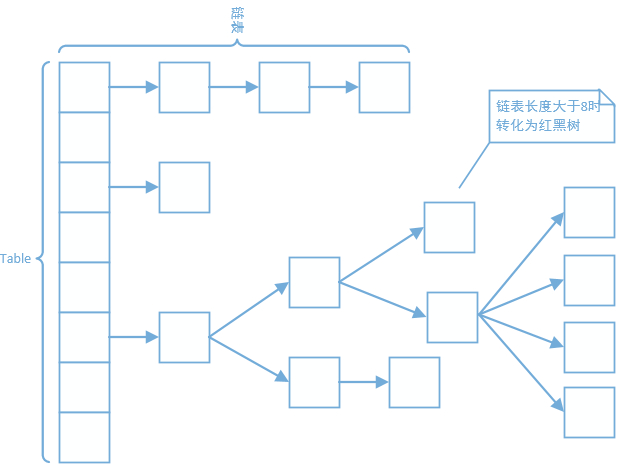Java - HashMap的链表超过8就转为红黑树吗?
抛出问题
最近看了一些有关HashMap的博客,似乎一提到链表转红黑树,统一的答案都是:链表长度超过8就转,那这个答案是对的吗?下面通过代码实例简单说说这个问题。
如果想了解更多HashMap的细节,推荐下面的博客:
内部结构
参考一下,下面的图片有个直观的感受

源码层面
先看一下 HashMap 的 treeifyBin() 方法:
/**
* Replaces all linked nodes in bin at index for given hash unless
* table is too small, in which case resizes instead.
*/
final void treeifyBin(Node<K,V>[] tab, int hash) {
int n, index; Node<K,V> e;
if (tab == null || (n = tab.length) < MIN_TREEIFY_CAPACITY)
resize();
// bala bala 已经省略
}
该方法中MIN_TREEIFY_CAPACITY 是这么定义的: static final int MIN_TREEIFY_CAPACITY = 64;, 所以在做链表转树的时候,还会判断node数组的长度是否<64,如果小于则resize,也就是扩容 * 2。
代码示例
我们从以下几个步骤出发,验证是否真的长度超过8的链表会转为红黑树:
- 定义一个类作为HashMap的
key; - 该类的每个对象的hashCode都是一致的,这里我们始终返回
1,为了模拟冲突 - 通过反射获取到
table,也就是HashMap内部存储<key,value>的Node数组 - 逐个遍历Node,若有冲突,则获取当前冲突节点的next节点
- 若是已经转为红黑树,我们直接打印其类型,作为确认
package com.amos.collection;
import java.io.Serializable;
import java.lang.reflect.Field;
import java.util.HashMap;
import java.util.Map;
public class HashMapTest implements Serializable {
private static final long serialVersionUID = 7412605125132816598L;
public static void main(String[] args) throws IllegalAccessException, NoSuchFieldException {
Map<Key, Integer> map = new HashMap<>(16);
// 制造冲突, 使得某个索引处节点个数 = 8
for (int i = 0; i < 8; i++) {
map.put(new Key(i), i);
}
Class<? extends Map> mapClass = map.getClass();
Field table = mapClass.getDeclaredField("table");
table.setAccessible(true);
Object[] objects = (Object[]) table.get(map);
System.out.println("table size=" + objects.length);
int index = 0;
for (Object o : objects) {
System.out.print("index: " + index++ + "; ");
printNext(o);
}
System.out.println("如果size不足64,则增加新的一个元素之后, 必定触发resize(), 容量 * 2");
// 将桶里面的元素 + 1 ,以前是8 现在是9
map.put(new Key(8), 8);
index = 0;
objects = (Object[]) table.get(map);
System.out.println("table size=" + objects.length);
for (Object o : objects) {
if (o != null) {
// 判断 table 内存储的到底是TreeNode 还是 Node
if ("Node".equals(o.getClass().getSimpleName())) {
System.out.print("index: " + index + "; ");
printNext(o);
} else {
System.out.println(o.getClass().getSimpleName());
}
}
index++;
}
}
/**
* 打印node以及node所有下一个 node
*
* @param node
*/
private static void printNext(Object node) throws NoSuchFieldException, IllegalAccessException {
if (node == null) {
System.out.println("当前节点为null");
} else {
System.out.println(node);
Field next = node.getClass().getDeclaredField("next");
next.setAccessible(true);
// 循环打印next节点
printNext(next.get(node));
}
}
public static class Key {
private Integer value;
public Key(Integer value) {
this.value = value;
}
public Integer getValue() {
return value;
}
public void setValue(Integer value) {
this.value = value;
}
@Override
public boolean equals(Object o) {
if (this == o) return true;
if (!(o instanceof Key)) return false;
Key key = (Key) o;
return getValue() != null ? getValue().equals(key.getValue()) : key.getValue() == null;
}
@Override
public int hashCode() {
// return getValue() != null ? getValue().hashCode() : 0;
return 1;
}
}
}
打印结果为:(省略一部分不重要的)
table size=16
index: 0; 当前节点为null
index: 1; com.amos.collection.HashMapTest$Key@1=0
com.amos.collection.HashMapTest$Key@1=1
com.amos.collection.HashMapTest$Key@1=2
com.amos.collection.HashMapTest$Key@1=3
com.amos.collection.HashMapTest$Key@1=4
com.amos.collection.HashMapTest$Key@1=5
com.amos.collection.HashMapTest$Key@1=6
com.amos.collection.HashMapTest$Key@1=7
当前节点为null
index: 2; 当前节点为null
… 省略的内容
如果size不足64,则增加新的一个元素之后, 必定触发resize(), 容量 * 2
table size=32
index: 1; com.amos.collection.HashMapTest$Key@1=0
com.amos.collection.HashMapTest$Key@1=1
com.amos.collection.HashMapTest$Key@1=2
com.amos.collection.HashMapTest$Key@1=3
com.amos.collection.HashMapTest$Key@1=4
com.amos.collection.HashMapTest$Key@1=5
com.amos.collection.HashMapTest$Key@1=6
com.amos.collection.HashMapTest$Key@1=7
com.amos.collection.HashMapTest$Key@1=8
当前节点为null
从上述打印内容可以看出,实际上当table size=16的时候,并且某个Node因为冲突而导致链表长度=8,再次插入到该链表处使冲突+1,并未转为红黑树。
为了使得链表转为红黑树,我们可以在初始化的时候,给HashMap的长度赋值为64,也就是修改为:
Map<Key, Integer> map = new HashMap<>(64);
然后再执行代码,结果如下:
table size=64
index: 0; 当前节点为null
index: 1; com.amos.collection.HashMapTest$Key@1=0
com.amos.collection.HashMapTest$Key@1=1
com.amos.collection.HashMapTest$Key@1=2
com.amos.collection.HashMapTest$Key@1=3
com.amos.collection.HashMapTest$Key@1=4
com.amos.collection.HashMapTest$Key@1=5
com.amos.collection.HashMapTest$Key@1=6
com.amos.collection.HashMapTest$Key@1=7
当前节点为null
index: 2; 当前节点为null
… 省略的内容
如果size不足64,则增加新的一个元素之后, 必定触发resize(), 容量 * 2
table size=64
TreeNode
从上述打印内容可以看出,因为table size=64满足了转为红黑树的条件:
- 当前HashMap的size>=64
- 某一个节点冲突导致链表长度>8
以上。
posted on 2020-10-09 17:17 AmosChen 阅读(16) 评论(0) 编辑 收藏 举报 来源



